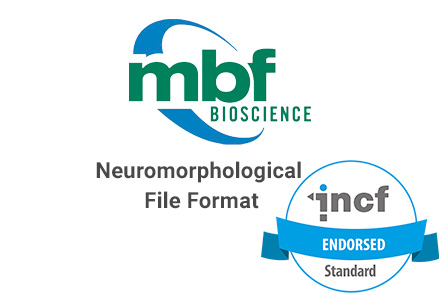
INCF endorses the MBF neuromorphological file format
21 March 2022On January 25, the INCF Standards and Best Practices committee endorsed the MBF neuromorphological file format v 4.0, as a standard. It is commonly known as “Neurolucida XML” and is used for digital reconstruction & modeling structure for microscopic anatomies.
The file format is widely used in the community, including the NIH-funded Stimulating Peripheral Activity to Relieve Conditions (SPARC) program. MBF’s participation in SPARC led to a collaboration with the FAIR Data Informatics lab at UCSD, and inspired MBF Bioscience to adapt the XML file format further in order to facilitate FAIR data management.
The endorsement statement is published on F1000
We are pleased to inform you that MBF Bioscience’s neuromorphological file format is endorsed as an INCF standard, albeit with reservations based on community feedback. All INCF standards undergo re-review every two years. MBF Bioscience and INCF will work together to further improve the FAIRness of the standard until the next review, including implementation of the governance policy and modification of the standard’s license from the CC-BY-ND-NC to a CC-BY-ND.
The committee is pleased to see an open format from a commercial entity go through the endorsement process, and applaud MBF Bioscience for taking this very important step in support of open and FAIR neuroscience. The committee considers the governance process for MBF Bioscience’s neuromorphological file format to be well elaborated, with a sufficient mechanism for the user community to request format updates.
MBF Bioscience was founded in 1988, with the aim to develop neuroanatomical image software for the research community. Over the years, their scope has broadened to include a variety of fields including stem cell research, cancer research, lung, kidney, reproductive, cardiac and toxicology research.Their file formats for digital reconstructions have evolved over the years. In 2007, MBF created the first XML-based MBF neuromorphological file format to be able to meet user community interest in representing a wider range of neuromorphological structures, and will continue to be updated as needed to define added or modified data elements.
The file format includes two organizational aspects, elements, and attributes. All data files have a header section that includes the file’s introductory content followed by any traced data elements that represent structures found in the microscopy image data. Each modeled object is represented as a unique data element, and there are mechanisms for grouping any number and type of data elements. File-level metadata is retained to allow provenance tracking of derivative data; it includes the application name, the application version and the RRID for the application. It uses a second RRID to identify the institution that produced the software which generated the file.
MBF Bioscience plans to develop a publicly available Python tool for reading and writing the neuromorphological format, and will invite users to adapt it for their specific needs.
Read more:
MBF Bioscience’s file format in the INCF SBP portfolio: https://www.incf.org/mbf-file-format-v-40
The paper describing MBF’s file format in detail:
Sullivan, A.E., Tappan, S.J., Angstman, P.J. et al. A Comprehensive, FAIR File Format for Neuroanatomical Structure Modeling. Neuroinform (2021). https://doi.org/10.1007/s12021-021-09530-x
More about MBF and SPARC: https://www.mbfbioscience.com/mbf-sparc

